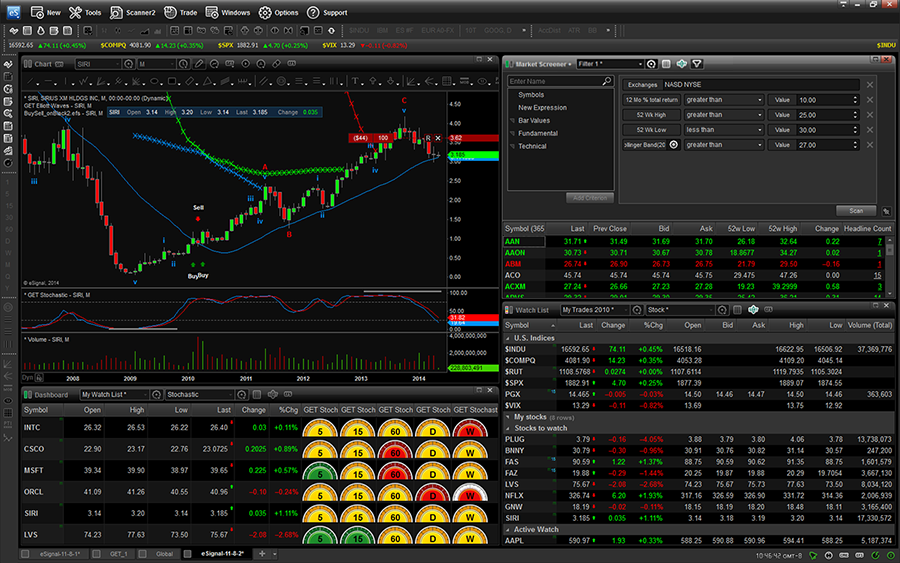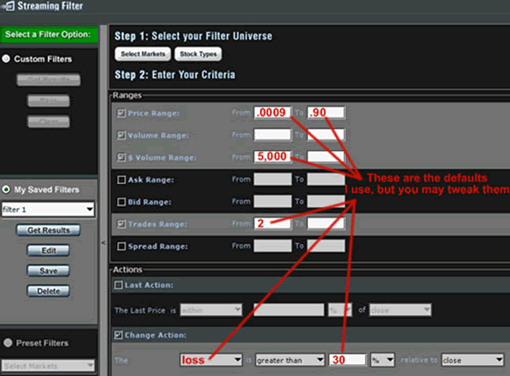Stock Screens Scans for Traders Investors
Post on: 27 Май, 2015 No Comment

As a part time trader & investor, I strictly use end of day data for my screens and scans as I don’t have the luxury of watching the tape all day long (nor do I want to). With that said, I do receive text alerts if a buy signal is made or if a sell signal has been violated. Using my smart phone or tablet, I can and do trade during business hours (when absolutely necessary) but it’s not imperative.
I encourage investors and traders in all time frames to evaluate stocks for investment using both fundamental and technical analysis. A day trader and even a swing trader can get away with avoiding fundamental analysis but I highly recommend both methods of analysis for intermediate and longer term trend traders and investors. Both tools are equally important in making serious decisions with your hard earned CASH!
Let’s start with a list of the key fundamentals that I require to be filtered within my mechanical screeners (please note that you should use your screener of choice):
Simple Fundamental Screener Criteria:
The criteria listed in this section can be used together or arranged in a variety of ways to generate multiple screens containing all possible opportunities. Get a feel for specific screens and determine which are the most successful during certain market conditions.
Most Important Fundamentals:
- Increasing Earnings (current, past: quarterly, yearly and future estimates)
- Increasing Sales (current, past: quarterly, yearly and future estimates)
- Increasing Net Income (current, past: quarterly, yearly)
- Increasing Institutional Sponsorship
- Increasing and strong Relative Strength ratings vs. general market
Most Important Price Data:
- Stocks making New Highs
- Stocks within 15% of New Highs
- Stocks trading slightly above or within 5% of the 50-d ma
- Stocks within 10% of the 200-day moving average (in weaker markets)
Less Important Metrics:

- Increasing Return on Equity (ROE)
- Price / Earnings Growth (PEG) – less than 1 is preferable
- Accumulation/Distribution ratio (up days vs. down days)
- Up / Down Volume over past several months
Fundamental screeners will scan thousands of stocks narrowing down the universe to a couple dozen to a few hundred each night or weekend. The more bullish the market, the larger the list of stocks will be and vice versa for weak markets. From here, the savvy investor turns to technical analysis to identify “when” and “where” to place a new position for the ideal risk-to-reward ratio.
General Market Metrics & Technical Analysis:
- Determine if overall market is in a specific trend (up, down or sideways). Use multiple moving averages to quickly determine the trend.
- Evaluate sister stocks or stocks within the same industry group (strength travels in groups so the probability of success rises when buying into a strong industry).
- Study the one year weekly chart (preferably candlesticks)
- Study the six month daily chart (preferably candlesticks)
- Look for increasing accumulation days (stock up on above average volume)
- Evaluate the Point & Figure chart for clean support and resistance levels
- Look for basic chart patterns such as flat bases, cup bases, saucer bases, triangle breakouts, obvious trends along a moving average, etc…
- Properly forming bases
- Pivot points
- Breakout areas
- Extended stocks
- Stocks pulling back to key support lines
- Favorable risk-to-reward setups
- Check volume action when bases are formed
Market Breadth – Using Screens
It is extremely important to pay attention to the quantity of stocks making your screeners from time to time. The length of the list alone will tell you how healthy or how weak the market currently is, without even checking another factor.
For example, a standard screen of mine searching quality stocks making new highs should be full of candidates during a fresh up-trending market. The list should be full of candidates as long as the trend continues. As soon as this list starts to thin out on a daily and weekly basis, become cautious that the breadth is weakening.
Example of my most successful screens:
When scanning these screens, I will view the stocks in descending order starting with the day’s largest price percentage change and occasionally starting with the day’s largest volume change versus 50-day average.
1. Quality Stocks that are trading within 15% of 52-week Highs
- Current price is within 15% of the 52-Week High
- Earnings increasing qtr-over-qtr and year-over-year
- Relative Price Strength greater than 80% of the general market
- Current 50-Day Average Volume is at least 100k shares per day
- % Increase in Volume (Current Day) vs. 50-Day Average Volume: Volume 50% larger than the 50-d average
2. Quality Stocks making New 52-week Highs:
- Current price is trading at a new 52-Week High
- Earnings increasing qtr-over-qtr and year-over-year
- Relative Price Strength greater than 80% of the general market
- Current 50-Day Average Volume is at least 100k shares per day
- % Increase in Volume (Current Day) vs. 50-Day Average Volume: Volume 15% larger than the 50-d average
3. Institutional Sponsorship Increasing
- % of the number of Institutions for Current Quarter vs. Prior Quarter have increased by 10%
- % of the number of shares owned by Institutions for Current Quarter vs. Prior Quarter have increased by 5%
- Earnings increasing qtr-over-qtr and year-over-year
- Relative Price Strength greater than 50% of the general market
- Current 50-Day Average Volume is at least 100k shares per day
4. Quality Stocks with a new IPOs within the past two Years
- Current price is greater than or equal to $10 per share
- Earnings increasing qtr-over-qtr and year-over-year
- Relative Price Strength greater than 80% of the general market
- Market Capitalization is greater than or equal to $ 100M
- Current 50-Day Average Volume is at least 50k shares per day
- % Increase in Volume (Current Day) vs. 50-Day Average Volume: Volume 50% larger than the 50-d average
- IPO Date within past 5 years (sometimes use 3 years)
Although I run these screens at least once per week, one or two will come into favor while others fall out of favor depending on the market environment or situation. Over time, the strength and weakness of certain screens will also give you a hint as to what the overall market is doing (another breadth signal).
For example, a screen that locates quality stocks making new 52-weeks highs is best used when a market is forming a new up-trend and the overall movement is still fairly fresh. This screen is less important near the end of a strong up-trend because at this point, many of the stocks making new highs are exhausted. The trader will see more failed breakout attempts, reversals and late stage bases so the odds are no longer in favor of this screen.
In strong up-trending markets, one cannot expect to buy every stock that makes the screens so it comes down to developing a risk-to-reward calculation to grab shares in the equities that show the greatest upside.
Lastly, it’s important to understand that no investor is perfect and losses are part of the game when it comes to investing and trading. Most traders will have as many winners as they do losers (using successful screeners) so having sell rules is critical for sustainable success. Learn to cut losses short while letting winners run, no questions asked.
By cutting losses, you account will not blow-up and you will be around to trade another day, especially when your screens are screaming buy!














